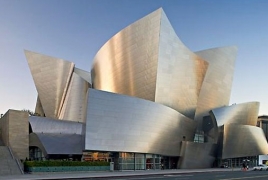 When imagination has no boundsWorld’s strangest buildings. Part I Matured and amateur architects have brought many amazing buildings to the world, challenging nature’s miracles. Quirky shapes, ambitious designs, new materials and various styles create an impressive picture of modern architecture from sky scrapers to weird stone constructions. PanARMENIAN.Net - Ideal Palace, France French postman Ferdinand Cheval’s Ideal Palace (Palais idéal) stands as a testament that a person can achieve anything with time, effort and passion. Cheval dedicated 33 years of his life constructing an incredible limestone palace, complete with pillars, buttresses and grottoes. Unique in the world, the Ideal Palace has inspired artists for more than a century. Independent from any artistic trend, built with no architectural rules, the Ideal Palace has been admired by the Surrealists and is considered as an Outsider Art work. He has been classified Historical Monument in 1969 by André Malraux, French Minister for Cultural Affairs at that time under Naïve Art. The Basket Building, U.S. The brainchild of the founder of the Longaberger Company (an American manufacturer and distributor of handcrafted maple woodbaskets and other home and lifestyle products), the distinctive "Basket Building" is located in Newark, Ohio, U.S. The building is a 160 times replica of one of the company's signature products, the Medium Market Basket. A seven story stucco over steel structure the "Basket Building" has become an icon and attracted media attention from around the world. Constructed in the 1990's the building opened for business in December 1997. Nautilus House, Mexico The Nautilus house located near Mexico City is a unique shell shaped house designed by local architect Javier Senosiain. Built with a technique called ferrocement construction, a frame of steel-enforced chicken wire is coated with concrete, allowing for rounded, natural curves, the inside is full of spirals, circles, and organically shaped rooms that mimic the concave chambers one would expect inside a giant mollusk. Hundreds of small rainbow-colored stained-glass windows line spaces of ceiling and walls alike, sunning lush grass that surrounds flower-shaped couches. The Crooked House, Poland Located in Sopot, Poland, this commercial building is a popular landmark for tourists and photographers. Built in 2004 by the design team of Szotynscy & Zaleski, this 4,000 sq. meter building is part of the Rezydent shopping center. The local name of the building is Krzywy Domek which translates into English as "Crooked House" and is home to many popular shops, restaurants, and even a radio station. Lotus Temple, India The Lotus Temple, located in New Delhi, India, is a Bahá'í House of Worship completed in 1986. Notable for its flowerlike shape, it serves as the Mother Temple of the Indian subcontinent and has become a prominent attraction in the city. The building is composed of 27 free-standing marble-clad "petals" arranged in clusters of three to form nine sides, with nine doors opening onto a central hall with height of slightly over 40 meters and a capacity of 2,500 people. Museum of Contemporary Art, Brazil The Niterói Contemporary Art Museum is situated in the city of Niterói, Rio de Janeiro, Brazil, and is one of the city’s main landmarks. Designed by Oscar Niemeyer with the assistance of structural engineer Bruno Contarini, the 16-meter high building is recognized by its saucer-shaped cupola, which has a diameter of 50 meters and three floors inside it. Habitat 67, Canada Habitat 67, designed by the Israeli-Canadian architect Moshe Safdie as the Canadian Pavilion for the World Exposition of 1967, was originally intended as an experimental solution for high-quality housing in dense urban environments. Habitat 67 comprises 354 identical, prefabricated concrete forms arranged in various combinations, reaching up to 12 stories in height. Together these units create 146 residences of varying sizes and configurations, each formed from one to eight linked concrete units. The complex originally contained 158 apartments, but several apartments have since been joined to create larger units, reducing the total number. Each unit is connected to at least one private terrace, which can range from approximately 20 to 90 square meters. Stone House, Portugal Located in the Fafe mountains of northern Portugal, A Casa do Penedo, or “the House of Stone,” was built between four large boulders found on the site. The residence was initially used by the owners as a holiday destination. Although the house may seem rustic, it is not lacking in amenities, which include a fireplace and a swimming pool carved out of one of the large rocks. Guggenheim Museum, Spain The Guggenheim Museum Bilbao is a museum of modern and contemporary art, designed by Canadian-American architect Frank Gehry, and located in Bilbao, Basque Country, Spain. With 24,000 square meters, of which 11,000 are dedicated to exhibition space, the Museum represents an architectural landmark of audacious configuration and innovating design, providing a seductive backdrop for the art exhibited in it. The Church of Hallgrimur, Iceland Hallgrímskirkja (church of Hallgrímur) is a Lutheran parish church in Reykjavík, Iceland. It is the largest church of the country with a seating capacity for 1200 people in the nave. State Architect Guðjón Samúelsson's design of the church was commissioned in 1937 and is said to resemble the basalt lava flows of Iceland's landscape. The church is also used as an observation tower. One can take a lift up to the viewing deck and view Reykjavík and the surrounding mountains. Lusine Mkrtumova / PanARMENIAN.Net How collection of horned creatures turned into museum New York’s first female crime boss World’s largest boneyard An Italian photojournalist’s journey through the pandemic Quarantine in metropoles Town without newborns and dead Nine months in the Pacific |